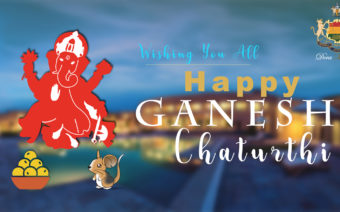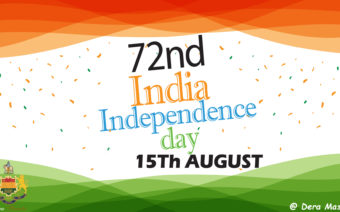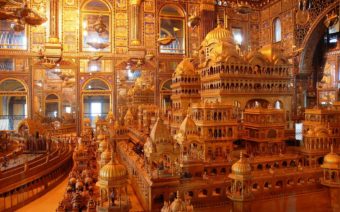
The Ajmer Jain temple, also known as Soniji Ki Nasiyan, is an architecturally rich Jain temple. It was built in the late nineteenth century. The main chamber, known as the Swarna Nagari “City of Gold”, has several gold-plated wooden figures, depicting several figures in the Jain religion. Greatly revered by the Digambar sect of the Jains, the Nasiyan temple is dedicated to Lord Rishabhdev, first of the 24 tirthankara by Rai Bahadur Seth Moolchand and Nemichand Soni. It is situated on Prithvi Raj Marg in Ajmer, the heart of Rajasthan state in India. The foundation of this magnificent Jain temple was laid on 10 October 1864 and the image of the first Tirthankar Lord Rishabhdev (Adinath), was installed in the Sanctum Sanctorum on 26 May 1865. This work was carried out under the able guidance of the great scholar Pandit Sadasukhdasji of Jaipur. But the hidden gem in Ajmer is Soniji Ki Nasiyan aka Lal mandir that was built over 100+ years back by a rich Jain businessman or a Seth. What you see here is a huge hall 90 ft X 65 ft X 92 ft in dimension, with a diorama of a complete Jain city Ayodhya Nagari. At the time of the birth of a Jain saint Adinath. There is a complete 3 storied palace built with scenes depicting the life of the city. The huge armies of elephants and horses are depicted on the ground. There are devas or demigods on their planes coming to visit the earth at the city of Ayodhya made holy by the birth of the saint Adinath. The walls adorn the glass paintings showing scenes and stories from the Jain scriptures.
The whole aura is of grandeur, divinity, and celebration. It is said that the models were created and showcased in Jaipur before they were brought here. You can view this huge piece of sculpture only through a small opening in the walls of the hall. And that too through a glass. But for the security reasons, you want to step inside and feel like how a literally golden city would be. For some reason, I had never heard of this place until I actually landed in front of it. This was the hidden surprise of this trip of mine.
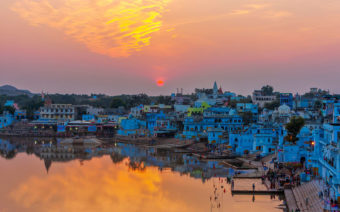
Pushkar Lake or Pushkar Sarovar is a sacred lake located in the town of Pushkar in Ajmer of the Rajasthan State of western India. It is a sacred lake of the Hindus. The Pushkar Lake is one of the most prominent spots of pilgrimage as well as the site of the world famous Pushkar Fair. Encircled by numerous temples and ghats. The lake draws thousands upon thousands of devotees every year to its threshold to gain spiritual distinction and attain salvation by taking a dip in its holy waters. The lake has incredible historical and religious significance. Its significance is mention in several Hindu Texts and sources and is primarily associated with Lord Brahma, who is considered as the creator out of the trinity of Gods- Brahma, Vishnu & Mahesh. According to most versions of the legend associated with the lake, when Lord Brahma killed demon Vajranabha, three petals of His divine lotus fell at three parts, creating springs in their place, known as Pushkar. Later on, Brahma also performed a yagna at the place. However, at the end of this ritual, he got cursed by his first wife that, he will be worshipped at this spot only. The lake is one of the holiest sites for Hindus and the place is accessed mostly for religious purposes only. The lake is surrounded by 500 temples and 52 ghats with different religious significance. People from all across the country and from all walks of life come here to take a dip in its sacred waters. It is said that taking a bath in Pushkar during Karthik Poornima (Full Moon Day), in the month of Karthik i.e October- November assumes special importance as it is considered highly auspicious. It is also said that taking a bath in this lake during Kartika washes all sins and absolve the devotees of bodily ailments especially skin diseases. The Lake has been marked as one of the ten most religious places in the world and one amongst the five top sacred places for Hindus in India. The site is also home to the world’s only Brahma Temple. The ambience and spiritual atmosphere at the ghats is amazing and offers a close understanding of Hindu beliefs and practices.
Ganesh Chaturthi, also known as Vinayaka Chaturthi (Vināyaka Chaturthī) or Vinayaka Chavithi is a Hindu Festival celebrating the birth of Ganesha. A ten-day festival, it starts on the fourth day of Hindu Lunisolar calendar month Bhadrapada, which typically falls in the months of August or September of the Gregorian calendar. The festival is marked with the installation of Ganesha clay idols privately in homes, or publicly on elaborate pandals. Observations include chanting of Vedic hymns and Hindu texts such as Ganpati Upanishad, prayers and vrata(fasting). Offerings and prasadam from the daily prayers, that is distributed from the pandal to the community, include sweets such as modaka believed to be a favorite of the elephant-headed deity.
Wishing You All Very Happy Ganesh Chaturthi!
Warm Wishes to you All from Dera Masuda Luxury Resort !!
Happy Raksha Bandhan !!
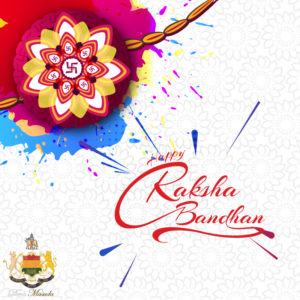
“Peace begins with a smile.”
Wishing you All “72nd Happy Independence Day” !!!





